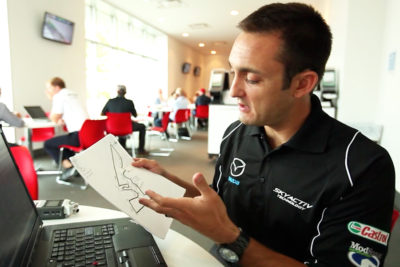VIRginia International Raceway (VIR) has a diversity of corner types. The lap starts out tighter and more technical, then flows into a high-speed momentum section before finishing up with some “compromise” type corners. With the variety of corners and elevation changes that VIR offers drivers, you’re in for quite a treat whether you’re a regular or it’s your first visit!
And remember, slow hands for high speed, quicker hands for low speed, and smooth hands all the time.
“Fast hands for slow corners, and slow hands for fast corners” is a philosophy that can apply to any driver’s approach, and it’s something I continually utilize with my private coaching clients. It’s a great method for diagnosing your driving through each corner, either live or retrospectively. My home track of VIR has some great examples of these different types of corners and the steering inputs they require.
Fast Hands for Slow Corners
There are several corners at VIR under 65mph, which puts them in the “slow corner” category. A lot of these are in the first part of the lap at VIR; it’s very important to change your mindset for Turns 1-6 after being at such high speeds on the back half of the lap and front stretch.
Turns 4-5 really lend themselves to fast hands: you turn in for a late apex; stay left at the exit to set up for Turn 5, which changes direction back to the right. This is one of several compromise corners on the circuit – compromising your ideal exit line to set up for the next corner. When properly done, a quick steering input back to the right from Turn 4 exit into Turn 5 will set the car up on an intended path that allows for full throttle all the way through to the Lower Esses in most low-to-medium powered cars.
Additionally, the transition from Turns 14-15 requires fast hands as this is another direction change you’ll want to compromise to optimize this sector.
And what about Turn 1? It’s relatively slow as well; however, this turn is in its own category because of the radius being very large and long. If your hands are too fast, you’ll apex too early. I find Turn 1 to be one of the most difficult corners to be consistent on the circuit. The corner requires a smooth, gradual input from turn-in all the way to the apex. Fast hands and turning quickly will get you to an early apex, and you’ll be facing the wrong direction for ideal car placement at the mid-point of the corner.
Turns 3 and 10 (although 3 is a lot slower than 10!) both require a smooth, steady steering input to maximize lateral grip for the corner and, ultimately, speed. You’ll find that if steering inputs are too quick or abrupt, the car becomes too upset. One key strategy to slow your hands is to look farther ahead: the farther ahead you’re looking into the corner, the more time your brain has to tell your hands how to create the proper input.
Compromise Corners
In addition to Turn 4 being a compromise corner, Turns 13-15 are also an area where you have to compromise the ideal corner line to set up for the next. You’ll find that staying left of center at the top of the hill after braking for T13 following the backstretch will set you up better for 14 and 15, netting a faster sector time. That’s been data proven, no matter the car…
Turns 16 and 17 are the same, requiring a compromised line in T16 to get the best run through T17 and onto the front straight which is obviously the priority.
And remember, no matter the speed of steering input, you always want it to be done smoothly. It can still be a quick input, though, the smoother it is, the more willing the car (and tire) will be to accepting of the input to maximize its capable grip.
I always enjoy talking about a lap at VIR, so please come find me at Mazda Motorsports’ support trailer during the upcoming SCCA Super Tour Friday, April 12. Mazda racers can sign up for a complimentary 30-minute coaching session.
Mazda’s Support at the SCCA Runoffs: Sneak Peak
Mazda Motorsports will support the 2019 Runoffs with coaching, parts, tech and hospitality support, including the annual Mazda banquet dinner. Tom Long and Andrew Carbonell will be on-hand at VIR to provide coaching support for Mazda racers starting Monday, October 7 through Thursday, October 10. The sign-up sheet will be posted on the Mazda Motorsports trackside support trailer starting at the beginning of the event. James Painter, Steve Strickland and Josh Smith will be available for tech and parts support. Mazda’s dinner banquet, normally held on a Wednesday, will be held Tuesday, October 8.
Tom Long is a former Spec Miata National Champion, IMSA Michelin Pilot Cup series champion, and a podium winner in the IMSA WeatherTech SportsCar Championship. Learn more about Tom at www.tomlong.com.


 ACCESSIBILITY
ACCESSIBILITY